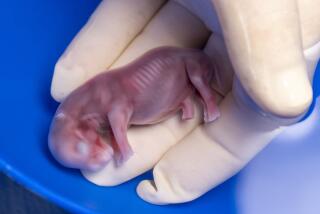Embryo of Meat-Eating Dinosaur Found : Science: The 80-million-year-old specimen may alter the beast’s image from ruthless predator to that of nurturing parent, researchers say.
- Share via
The first discovery of an embryo of a meat-eating dinosaur has been reported by a team of American and Mongolian researchers, who made the find in the windblown Gobi Desert.
The discovery of the 80-million-year-old embryo, curled up in its egg with its head between its knees, is likely to force a sharp change in the image of this dinosaur, researchers from the American Museum of Natural History report today in the journal Science.
Although the dinosaur, called oviraptor, has been considered a ruthless predator that raided the nests and killed the young of other dinosaur species, the new evidence suggests that it was instead a nurturing parent.
The team also found two skulls of newborn dinosaurs, which are among the rarest fossils in the world. Both the oviraptor embryo and these velociraptor skulls have many bird-like characteristics, providing strong new support for the emerging idea that birds evolved from dinosaurs.
The discovery provides “insight into issues of dinosaur behavior . . . that scientists are usually not able to explore,” said paleontologist Mark A. Norrell of the museum. “How did dinosaurs tend their nest? Did they take care of their young once they hatched? What were very young dinosaurs like?”
“It’s really great to see this fossilized behavior,” said Jacques Gauthier, curator of reptiles at the California Academy of Sciences in San Francisco. “It complements what we already know from the rest of anatomy. Birds are just barely modified dinosaurs, even down to their behavior.”
The find is “extremely significant,” said paleontologist Phillip Currie of the Tyrrell Museum of Paleontology in Drumheller, Alberta. Because most fossil eggs are empty, “there has been a lot of speculation about what therapod (meat-eating) dinosaur eggs looked like. Now we can tell whether other eggs are therapod as well.”
The first example of oviraptor was discovered in 1923 at a site called Flaming Cliffs in the Gobi lying sprawled over a nest of eggs, the apparent victim of a sudden sandstorm. The eggs were common in the area, and a plant-eating dinosaur called protoceratops was also the most common species, so researchers believed that the eggs were also protoceratops.
The researchers assumed that the dinosaur, a six-foot-tall, ostrich-like beast with long forelegs and a vicious beak, was stealing eggs from the nest and named it oviraptor or “egg seizer.”
The discovery that the eggs were not protoceratops but oviraptor indicates that the original researchers jumped to a hasty conclusion. Because the adult and the eggs were of the same species, Norrell said, their discovery was not of a predator laying waste to the nest of a different species but of a parent who probably died protecting its eggs from a storm, he said.
Another indication that oviraptor was a nurturing parent was that the six-inch-long eggs were not randomly jumbled in the nest like a reptile’s eggs, but were geometrically aligned in concentric circles or in a precise spiral with their narrow ends pointed toward the center of the nest. Many modern birds move their eggs in the same way.
“This is another indication that the types of behaviors we see in living birds have very, very deep roots within dinosaurian history,” Norrell said.
Equally important was the discovery of two small skulls in the nest that Norrell’s team has preliminarily identified as a different type of meat-eating dinosaur, probably velociraptors such as those made famous in the movie “Jurassic Park.”
The fact that only the skulls are present even though the nest was remarkably well-preserved, Norrell said, strongly suggests that the parent brought them to the nest as food for the young. That conclusion not only explains the unexpected presence of two species in the nest, but gives further evidence of the dinosaur’s nurturing. “If you go to an owl’s nest today, you’ll find little mouse heads lying around,” Gauthier said. “The mom is robbing other nests and feeding her young.”
What is remarkable about the velociraptor skulls is that they have tiny, peg-like teeth very similar to those observed in the earliest birds, which appeared about 150 million years ago. These teeth are very different from the “serrated steak knife” teeth of the adult meat eaters, who use the teeth for tearing apart their prey. The finding suggests that these young probably had a diet very similar to a bird’s, subsisting largely on insects, Norrell said.






